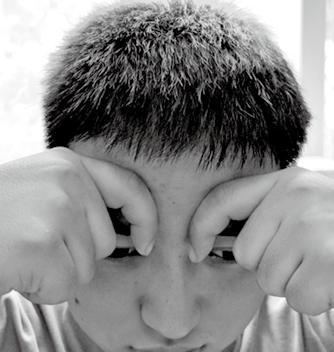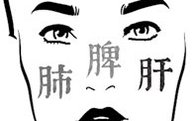Editor’s Introduction
The “Nanjing” states: “To know by observation is called spirit.” This emphasizes the importance of facial diagnosis in the process of diagnosing and treating diseases in Traditional Chinese Medicine (TCM). The “Danxi Heart Method” states: “What is within must manifest externally.” Through facial diagnosis, TCM practitioners can understand the internal state of the body. Next, I will briefly introduce how to assess health by observing the face.
1. The Importance of Facial Observation
TCM believes that the five organs and six bowels of the human body are connected to the face through meridians. The fullness of qi and blood in the organs reflects on the face, and changes in the facial appearance can indicate the condition of the internal organs and the changes in qi and blood. Moreover, since the face is the easiest area to gather information during diagnosis, facial observation is crucial, especially observing the facial color.
2. Observing Facial Color
First, we need to understand what a normal facial color is. A normal facial color should be a subtle red-yellow, bright and moist. TCM believes that the five colors—green, red, yellow, white, and black—differ from the normal facial color and can reflect abnormal changes within the body.
1. Green Color
A greenish face resembles the color of “green grass.” TCM associates green with cold syndromes, qi stagnation, blood stasis, pain, and convulsions. When there are issues with the liver, the face often appears greenish.
Typical Cases:
(1) A greenish complexion due to liver damage from staying up late: A young man came to me for treatment due to discomfort. I observed his face was green, and he seemed emotionally repressed. I asked if he had been staying up late or was angry recently. He admitted to feeling anxious and having insomnia for several days. This is an example of a greenish complexion caused by liver damage and qi stagnation from staying up late.
(2) A precursor to convulsions in children—greenish color around the nose and lips during high fever: I once treated a child with high fever and convulsions, and I observed a noticeable greenish color around the nose and lips. In TCM, high fever convulsions are called “acute convulsions,” and the appearance of greenish color around the nose and lips in children with high fever must be taken seriously as it indicates a precursor to convulsions.
2. Red Color
A red face resembles the color of a “rooster’s comb.” TCM associates red with heat syndromes. When there are issues with the heart, the face often appears red. However, heat syndromes can be differentiated into excess and deficiency types; excess heat should be treated with heat-clearing and fire-purging methods, while deficiency heat should be treated with yin-nourishing and fire-reducing methods, avoiding the blind use of cold medicines to reduce heat.
Typical Cases:
(1) A red complexion: I once treated a patient with hypertension whose face was red, especially on the forehead and cheeks, and his neck was also red. He spoke with difficulty, coughed up yellow phlegm, had constipation, and his tongue was red with a yellow greasy coating. The redness on the forehead indicated yangming syndrome, with gastrointestinal blockage causing the evil heat to rise and redden the forehead; the redness on the cheeks was a reaction to liver fire disturbance. Therefore, after differential diagnosis and treatment, the redness disappeared, and his blood pressure returned to normal.
(2) A red complexion due to deficiency of yang qi and excess of yin: In clinical practice, I once treated a young man whose face was flushed as if painted. He felt very hot, easily sweating small beads on his head, but his hands and abdomen felt cool to the touch. He craved hot drinks and felt fatigued. His tongue was pale with a white coating, indicating deficiency of yang qi and excess of yin.
3. Yellow Color
The color resembles “yellow earth.” TCM states that “yellow represents the spleen,” indicating spleen deficiency and dampness, often due to spleen deficiency leading to failure in transporting qi and blood to nourish the face; or dampness accumulating internally, causing the spleen to fail in its transformation, resulting in a yellowish complexion.
Typical Cases:
(1) A sallow complexion due to spleen deficiency: I once encountered a patient with diarrhea who experienced loose stools immediately after eating, felt fatigued, had dizziness and shortness of breath, and his complexion was sallow. This is a typical manifestation of spleen deficiency.
(2) A sallow complexion due to anemia: I once treated a female patient with anemia, as indicated by blood tests. She often felt numbness in her hands and feet, had a small menstrual flow, and frequently lacked appetite. Her complexion was sallow, and her nails were pale. This is a typical manifestation of blood deficiency, which, if it progresses, can lead to a pale complexion.

4. White Color
TCM believes that white represents deficiency syndromes, cold syndromes, blood loss, and qi depletion. If qi and blood are deficient, or if there is blood loss or qi depletion, it can lead to insufficient nourishment to the face; cold can cause qi stagnation, leading to slow blood flow and a relative decrease in blood; weak yang qi can fail to promote blood flow, resulting in a pale complexion. These factors can all lead to a pale face.
Typical Cases:A pale complexion due to qi and blood deficiency: In clinical practice, I once encountered a female patient who had been pale for half a month without obvious reason, felt short of breath and fatigued, and experienced palpitations with slight movement, with cold hands and feet. This is a manifestation of qi and blood deficiency. Subsequent blood tests confirmed anemia.
5. Black Color
A blackish face resembles the color of “deep water,” a bluish-black color. If black appears, it indicates that there is an excess of water qi in the body, referring to waste water or dampness, not normal body fluids. Patients with kidney deficiency often show a blackish complexion. Additionally, black is associated with cold syndromes, pain syndromes, and blood stasis. Of course, a person’s natural skin color, which remains unchanged throughout life, such as that of a person of African descent, is not considered an abnormal complexion.

3. Observing Facial Areas
TCM believes that different areas of the face correspond to different organs. If there is an abnormality in a specific area of the face, it indicates a corresponding issue.
The “Suwen: Discussion on Needle Heat” uses the face to observe the five organs (Figure 1). Clinically, patients with liver heat disease often show redness on the left cheek first; patients with heart heat disease often show redness on the forehead first.
Once, a patient asked why he had persistent acne on his chin. This is mostly caused by kidney deficiency and excess fire, and his complexion was also flushed. After appropriate TCM treatment, he quickly recovered.
Additionally, different facial features correspond to different organs, and diseases of the facial features can reflect changes in the internal organs. For example, sores on the nose, commonly known as “rosacea,” often belong to lung and stomach heat accumulation.
Of course, the above explanation is only a small part of facial observation and merely provides a preliminary impression of diseases. The final diagnosis still requires comprehensive assessment through the four examinations to arrive at an accurate conclusion.

Figure 1: Diagram of Facial Observation of the Five Organs
4. Tips for Facial Health Care
1. Forehead Scraping
Form a bow shape with the index fingers, placing the middle section of the index fingers against the thumb side tightly on the forehead, scraping from the center of the forehead along the brow ridge to the temples, repeating 30 times. (Figure 2)

Figure 2: Forehead Scraping
2. Facial Rubbing
Rub both palms together until they are warm, then place the warm palms tightly against the face, rubbing the cheeks gently from bottom to top until they feel warm.
3. Facial Mask
Mix equal amounts of Bai Fu Zi (Typhonium), Mu Dan Pi (Moutan Root), Mu Li (Oyster Shell), Fu Ling (Poria), and Chuan Xiong (Szechuan Lovage) into a powder, then mix with water or milk to form a thin paste. Wash the face with warm water, then apply a thin layer of this medicinal paste on the face, similar to a facial mask, and wash it off after it dries. This facial mask is called Yu Rong San (Jade Complexion Powder), which has the effects of dispelling wind, activating blood, and improving complexion. Consistent use can enhance skin tone.
Safety Production Month

“Your Health is in Your Hands”“
Click on the cover to enter the Yueyi Family TCM Academy to purchase this book
Content Introduction
This book discusses common health issues from head to toe, explaining their causes and mechanisms from a TCM perspective, providing practical and feasible comprehensive health maintenance plans, with specific methods and unique experiences. Additionally, the author introduces some basic concepts of TCM and other hot topics in TCM in an easy-to-understand manner, combining real-life examples. The book is rich in content, clear in thought, and provides a clear discussion of TCM, making it easy to understand health maintenance. With this popular science book at hand, readers can easily find corresponding solutions to related health issues, truly achieving “Your Health is in Your Hands!”
Previous Highlights
14 Years of Skin Cancer, 2 Classic Formulas for Itching and Skin Renewal
“The First Formula for Reducing Fever in History,” Master the 9 Major Effects in One Article
With this medicine, sleep peacefully and sweetly
 Copyright Statement
Copyright Statement
This article is excerpted from “Your Health is in Your Hands” (published by China Traditional Chinese Medicine Press, authored by Gao Shaofang and Wang Xiangting), reprinted from the “Traditional Chinese Medicine Publishing” WeChat public account, the final interpretation rights belong to the original author, recommended and published byYue Du TCM (WeChat ID: ydzhongyi), cover image source from Shetu Network, copyright belongs to the original author. If there is any infringement, please contact for deletion. Unauthorized reproduction is prohibited!

 Click“Read the Original” to purchase the recommended book
Click“Read the Original” to purchase the recommended book Share
Share Collect
Collect Click
Click View
View

